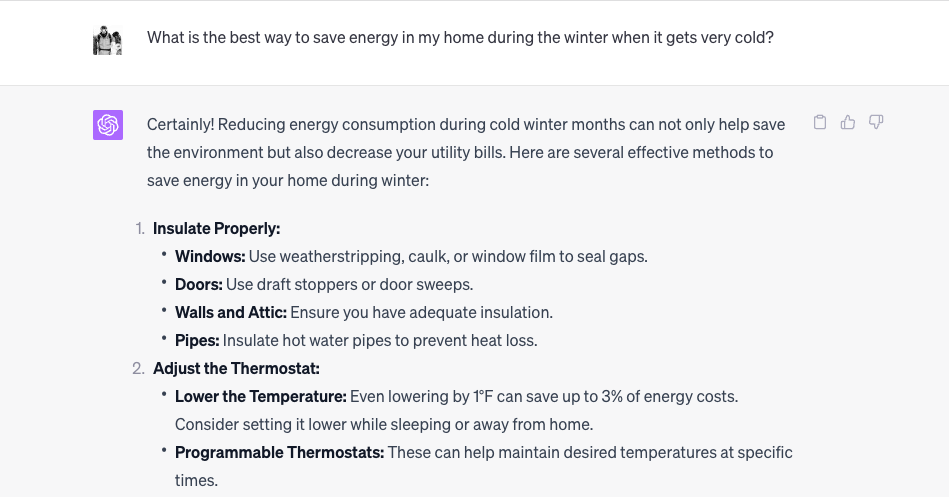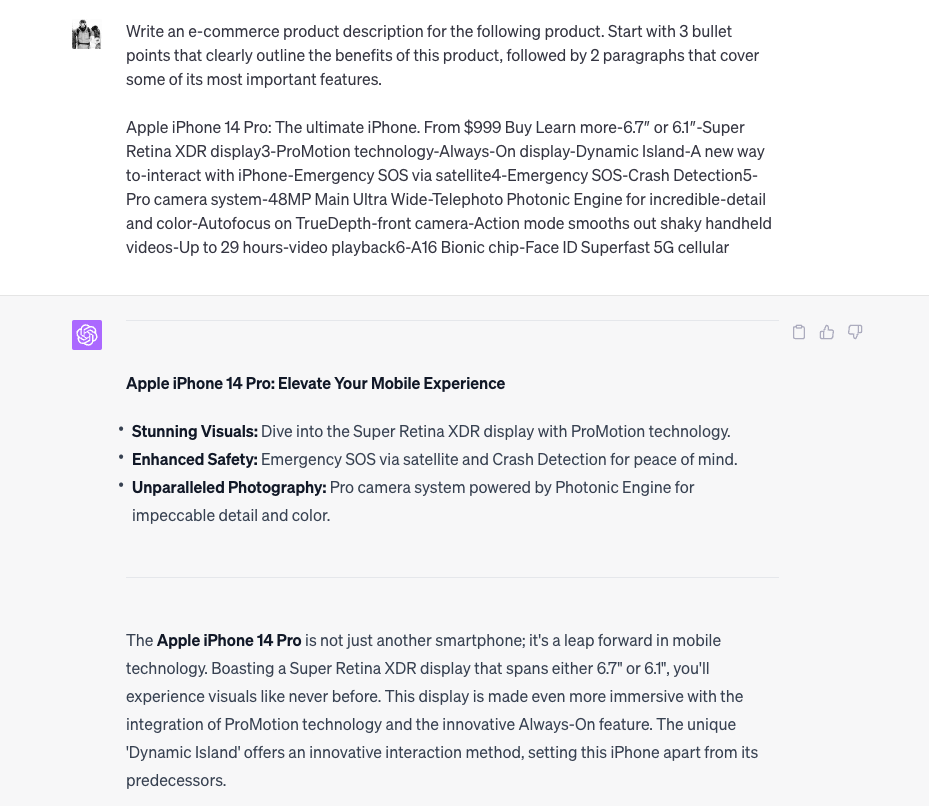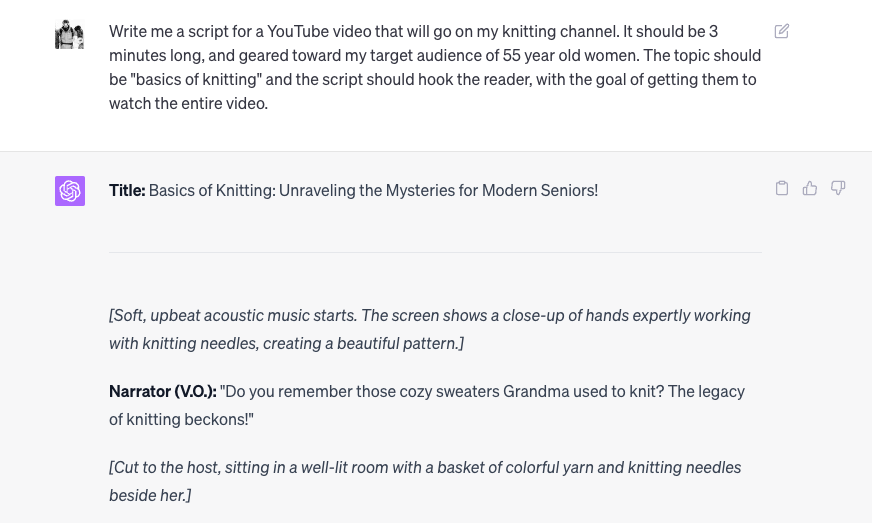
How to Write an Excellent ChatGPT Prompt
ChatGPT is an incredibly powerful tool. But most people aren't using it to it's potential! Like anything, in order to get high quality output you'll need to provide high quality inputs... and that's where "prompt engineering" comes in.
Prompts are the instructions you provide to ChatGPT. Good prompts = great results. Want AI support for content or language processing? Perfect your prompts.
Know the AI's quirks. Be clear. Give context. Follow these tips, and your ChatGPT game will be top-notch. Let’s get started!
Understanding ChatGPT Prompts
ChatGPT prompts play a crucial role in generating accurate and relevant responses from AI language models. As the input you provide to the AI, the prompt shapes the AI's understanding of your task or question.
A well-crafted prompt will yield more useful and accurate output, benefiting your communication with ChatGPT and making it a powerful tool for various purposes.
If you try to give ChatGPT a vague prompt with no context, you're not going to be happy with the results:

On the other hand, with specific instructions ChatGPT is capable of producing some seriously high quality output:

Prompts serve as the foundation for enhancing your interaction with ChatGPT, so it's important to master the art of crafting them.
Context in Prompts
Incorporating context into your prompts helps ChatGPT generate more applicable and meaningful responses. By providing essential background information and setting the framework for a conversation, context enables a smoother exchange with the AI.
To add context to your ChatG-PT prompts, consider:
- Specificity: Clearly state your intention, question, or topic to avoid ambiguity. Well-defined prompts lead to more consistent and coherent results.
- Relevance: Include important details relevant to your task or question. Avoid overloading your prompt with unnecessary information, as it may confuse ChatGPT.
- Format: Indicate the desired response format if relevant. This helps guide ChatGPT in crafting its output and improves the utility of the AI-generated text.
Remember, incorporating context in your ChatGPT prompts enhances your interaction with the AI and allows it to generate meaningful and applicable results for your tasks.
Crafting Effective Prompts
To craft effective ChatGPT prompts, it's crucial to use a specific format.
Providing a specific structure guides the AI language model to generate the desired output. For example, if you want to receive a list of items, you can start your prompt with "List the top 5..."
By setting a clear format, you help the AI understand your intent and navigate towards accurate and relevant responses.
Role-Play Prompts
Role-playing can be highly effective in obtaining the desired information from ChatGPT. While using role-play prompts, you position the AI as an expert or character with a specific role. For example, "As a historian, summarize the impact of the Renaissance on European society."
By assigning a role, you create context, enhance specificity, and guide the AI's response towards the expected knowledge base.
Clear Instructions
Explicit instructions play a vital part in crafting prompts. When interacting with ChatGPT, ensure your prompt has a clear directive, so the AI knows exactly what you expect in response.
Consider including additional background information to provide ample context. For example, instead of asking "What is the best way to save energy?", offer more context, specifying aspects such as household energy or industrial energy consumption.

Avoiding Ambiguity
To get the most out of ChatGPT, avoid using ambiguous language and terms that can have multiple interpretations.
Ambiguity arises when the AI cannot easily determine your intent or desired outcome. Using specific vocabulary tailored to your request will considerably improve the effectiveness of the model's response.
Keep your sentences concise and direct to ensure the AI accurately understands the core of your request.
Emotive Language Use
While it's vital to be clear and specific, incorporating emotive language can enhance the impact of your ChatGPT prompts.
By using emotion-based words, you establish the tone and provide the model with the context to generate a response that aligns with your desired emotion. For example, instead of writing "Describe a vacation," you can ask, "Describe a relaxing and rejuvenating vacation in a tropical paradise." This way, the AI will consider the emotional aspect while crafting its response.
Different Types of Prompts
Text-Based Prompts
Text-based prompts are the most common and straightforward type of prompts used with ChatGPT. To write an effective text-based prompt, ensure it is concise and clear.
You should avoid using ambiguous language that may lead to undesired responses. The better you articulate your question or requirement, the more likely you are to receive accurate and relevant replies from ChatGPT.
Dialogue Prompts
Dialogue prompts involve a back-and-forth exchange between you and the AI. They can be particularly helpful when trying to obtain more context or explore a specific topic in depth.
When crafting a dialogue prompt, remember to keep your messages brief and on topic. By structuring your conversation effectively, you can help guide ChatGPT's responses in the direction you want.
Emoji Prompts
Sometimes, incorporating emojis within your prompts can help convey the sentiment or context you're after. ChatGPT can recognize and respond to emojis, thereby generating responses that may align more closely with your desired outcome.
To maximize the utility of emojis, use them sparingly and in combination with text to provide a clearer context for the AI.
List Prompts
List prompts are ideal for requesting concise and organized pieces of information.
When you want ChatGPT to generate a list of items or ideas, ensure your prompt explicitly requests this format. For instance, if you want a list of brainstorming ideas, you could ask, "List five creative ways to approach a problem-solving task."
Table Prompts
Table prompts can help you present and request information in a more structured manner. By using a table format, you signal to ChatGPT that you want the AI to complete or generate content in that particular order.
Tables can be useful for extracting summaries, comparisons, or displaying data. Make sure to use a clear table format and provide accurate context to improve your chances of obtaining the desired information.
Remember to keep the tone of voice confident, knowledgeable, neutral, and clear throughout the section. By doing so, you'll effectively guide readers in crafting different types of prompts to get the most out of their interactions with ChatGPT.
Utilizing Prompts for Various Tasks
Product Description Crafting
When crafting product descriptions, you'll want ChatGPT to emphasize the unique selling points, benefits, and features of the product.
You can feed ChatGPT a bunch of unformatted information about the product, the right prompt, and end up with some killer product descriptions for your e-commerce store:

Creating Engaging Videos
Writing prompts for videos can be a daunting task, especially when the goal is to create engaging content for your audience. To accomplish this, try the following:
- Define your objective: Clearly state the purpose of the video and what you hope to achieve with it.
- Understand your audience: Identify the target viewers and tailor the content to their preferences and needs.
- Create a storyboard: Plan the video structure using a sequence of visuals and narrative cues.
- Incorporate impactful language: Use strong, descriptive words to evoke emotions and maintain the viewer's interest.
Check out this prompt for example:

By following these guidelines, you'll be able to generate unique, engaging video content.
Iterative Prompt Engineering
Iterative prompt engineering is a process of refining chatbot prompts based on user feedback and system performance. This technique can significantly improve the effectiveness of your ChatGPT by gradually optimizing its output. Here are a few steps to utilize iterative prompt engineering:
- Start with a simple, clear prompt: Design an initial prompt that is concise and easy for ChatGPT to understand.
- Analyze responses: Monitor the results from your prompt and identify areas for improvement.
- Adjust and refine: Modify the prompt to address the issues you've identified, taking into account both system performance and user feedback.
- Retest: Deploy the modified prompt and again analyze the responses.
- Repeat the process: Continue refining the prompt until you achieve the desired level of effectiveness.
Over time, this iterative process will lead to a more accurate and reliable ChatGPT, better suited to fulfilling your desired tasks.
Evaluation and Optimization of Prompts
Improving Prompt Creativity
To optimize your ChatGPT prompts, focus on enhancing prompt creativity. Think outside the box and consider diverse perspectives when crafting prompts. Ask questions from different angles and encourage the AI to explore various aspects of the topic. Here are a few approaches to enhance your prompt creativity:
- Rephrase questions: Explore different ways to word the same question to see which phrasing yields the best results.
- Combine related ideas: Merge related concepts or questions in a single prompt to challenge the AI and capture a broader perspective.
- Use open-ended queries: Encourage more comprehensive and creative responses by using open-ended questions instead of simple yes/no or multiple-choice queries.
Techniques for Prompt Evaluation
Once you've crafted creative prompts, it's essential to evaluate their effectiveness in eliciting the desired responses. Use these techniques to assess and improve your prompts:
- Compare responses: Utilize multiple prompt iterations and compare the AI's responses to identify which prompts generate the most accurate and valuable output.
- Accuracy assessment: Examine the AI-generated responses for factual correctness, logical coherence, and relevance to the prompt. Adjust your prompt accordingly if it does not produce an accurate response.
- Feedback loop: Continuously iterate on your prompts based on the evaluation results. Modify your prompts to provide clearer context or guidelines if necessary, and test the revised versions for better outcomes.
Remember, evaluating and optimizing prompts is an ongoing process. Continuously refining your prompts will ensure that you obtain the most valuable and accurate information from ChatGPT in a confident, knowledgeable, neutral, and clear manner.
What is ChatGPT NOT Good At?
There are plenty of areas ChatGPT is just not a great fit for. First off, it's trained on a language model that only goes up to 2021. So if you're asking it about news that happened last week, you're going to have a tough time (it'll probably just hallucinate).
Legal documents are another grey area. Any lawyer is going to say you'd be crazy to draft an asset purchase agreement or privacy policy with ChatGPT. That said, in a pinch ChatGPT will at least give you an output for requests like this. Sometimes it'll come with a legal disclaimer to smartly talk to a lawyer.
Managing Your ChatGPT Prompts
By applying these strategies we've covered so far, you will be well-equipped to create compelling and efficient ChatGPT prompts that cater to the needs of your business and your audience.
Now that you're an excellent prompt writer, you'll need a system to save and organize your prompts! Otherwise you'll be reinventing the wheel every time you need a prompt.
That's where PromptFolder comes in. Our app allows you to save, share, and discover ChatGPT prompts. Spend more time generating great AI outputs, and less time tediously rewriting prompts. Give it a try today!